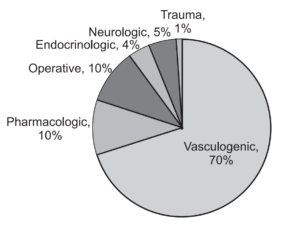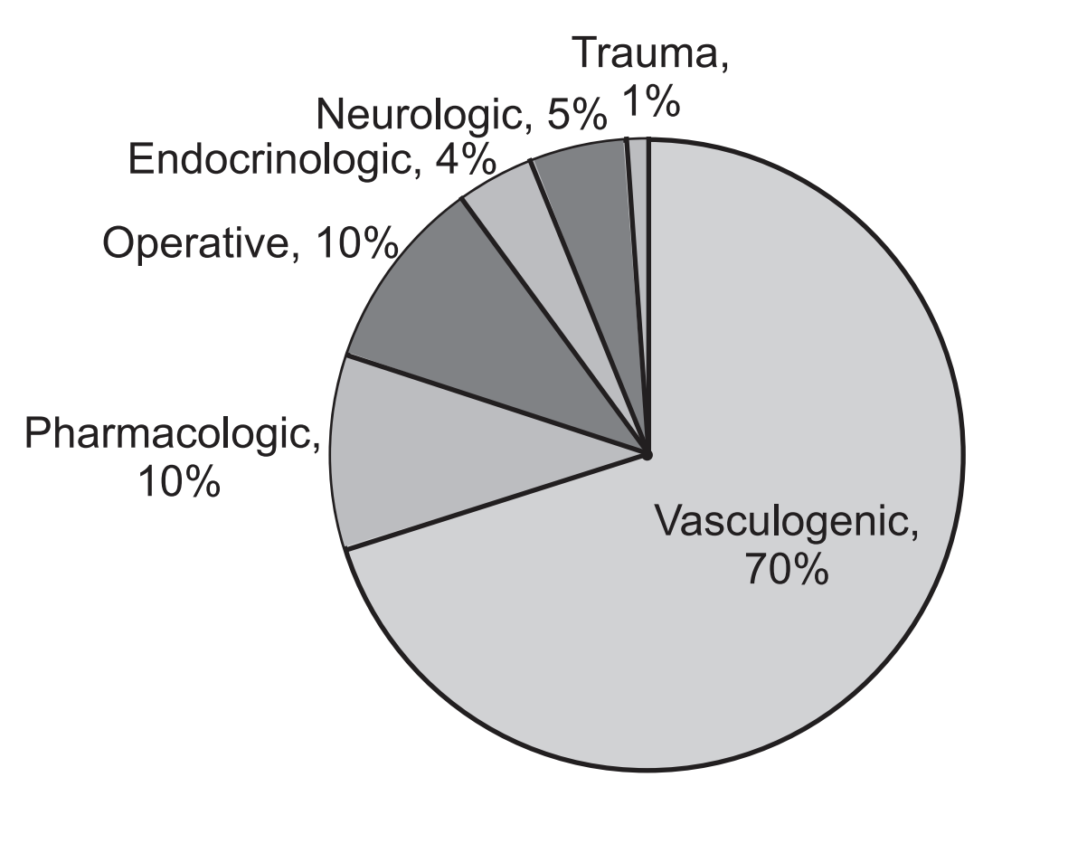Disorders of Sex Hormones in Males
Hypogonadism
Hypogonadism refers to the decreased production of testosterone. This can result
from the pituitary gland not stimulating the testicles to make testosterone or the failure
of the testicles to produce adequate testosterone. When testosterone levels are
low, men can experience decreased libido (sex drive), erectile dysfunction, decreased
energy, decreased muscle mass and thinning of the bones. Testicle size may also decrease and sperm count decrease.
Blood testing is done to diagnose hypogonadism and to determine the cause. MRI (magnetic resonance imaging) of the pituitary or testicular biopsy may be needed in some
cases. Testosterone when low can be replaced by injection, patches or topical gels.
Gynecomastia
The increase in breast tissue in a man is referred to as gynecomastia. This can occur during puberty and resolve on its own. Gynecomastia can also be due to medications, hypogonadism, thyroid disease, malnutrition, testicular cancers, adrenal cancers, liver disease or kidney disease. The cause of the gynecomastia is usually determined by physical exam, history and blood tests. Additional testing may include testicular ultrasounds or CT scan.
Erectile Dysfunction (ED)
Erectile dysfunction (ED) is the inability to attain or sustain an erection firm enough to have satisfactory sexual intercourse. It is also called as impotence. It is not unusual for this to happen to a man on occasion, but frequent ED can be a sign of a bigger medical problem that needs attention. ED becomes more common in older age but it is not a natural part of aging.
What Are The Causes For Erectile dysfunction (ED)?
ED can result from medical, physical or psychological factors. ED may be caused by a combination of factors that could also include medicine, alcohol or drugs. Intermittent ED is common. Many men experience occasional ED. It is generally caused by stress, exhaustion, or similar causes. Occasional ED should not be a cause of concern. Frequent ED may be a sign of damage to the cardiovascular or nervous systems. It is also be a sign of serious emotional or relationship difficulties.

Lifestyle Factors Associated With Erectile Dysfunction That Can Effect
There are a number of lifestyle factors that can cause or contribute to ED. In general, any behaviour that can damage cardiovascular or nervous system health can also increase ED risk. Some risk factors include: Smoking, alcohol use, using illegal drugs, such as cannabis, heroin or cocaine, being overweight or obese, failing to control diabetes and lack of exercise.
In addition, any activities that cause physical damage to the nerves or blood vessels around the base of the penis can also increase ED risk. For example, prolonged bicycling is associated with ED. However, this type of ED is usually temporary.
Medical Factors Associated With Erectile Dysfunction
Most common medical causes of ED are diseases or injuries to the cardiovascular system. These can reduce blood flow to the penis. Some cardiovascular conditions related to ED include:
- High blood pressure,
- Diabetes,
- Atherosclerosis,
- Obesity and metabolic syndrome,
- High cholesterol,
Nervous system problems related to ED include:
- Spinal cord injury,
- Parkinson’s disease,
- Multiple sclerosis.
Other medical factors associated with ED include:
- Prostate cancer,
- End-stage kidney disease,
- Radiation therapy to the pelvic region,
- Hormonal disorders including thyroid conditions and testosterone deficiency,
- Surgery on the prostate, bladder, or other organs near the penis,
- Structural/anatomical disorder of the penis, such as Peyronie disease,
- Injury to the penis, testicles, or surrounding area.
Physiological Mechanisms of Normal Males/Boys
Penile Erections
During sexual arousal, messages from brain travel down nerves to the penis. Neurotransmitters are then released from the ends of the nerves in the penis. Stimulation of penile shaft by the nervous system leads to the secretion of nitric oxide (NO), causing the creation of cyclic guanosine monophosphate (cGMP) which functions to relax blood vessels (vasodilatation). This allows extra blood to flood into the penis. The rapid inflow of
blood causes the penis to swell into an erection. The swollen inner part of the penis also presses on the veins nearer to the skin surface of the penis. These veins normally drain the blood from penis. So, the flow of blood out of the penis is also restricted, which enhances the erection. So erectile tissues in the corpus cavernosa can fill with blood, and subsequently cause a penile erection.
Phosphodiesterase type 5 (PDE5) is always present in the penis and functions to destroy cyclic GMP, causing vasoconstriction of erectile tissues and resulting in the loss of erection. In normal males, the loss of an erection occurs after orgasm and ejaculation of sperm.
Pathophysiology of Erectile dysfunction
From the mechanisms of a normal erection, erectile dysfunction may develop due to hormonal deficiency, disorders of the neural system, lack of adequate penile blood
supply or psychological problems. Restriction of blood flow can arise from impaired endothelial function due to the usual causes associated with coronary artery disease, but can also be caused by prolonged exposure to bright light.
Symptoms of Erectile dysfunction
Erectile dysfunction symptoms may include persistent:
• Trouble in getting an erection.
• Trouble in keeping enough erection to have intercourse or only be able to have brief erections.
• Reduced sexual desire.
Complications of Erectile dysfunction
Complications resulting from erectile dysfunction can include:
• An unsatisfactory sex life,
• Stress or anxiety,
• Embarrassment or low self-esteem,
• Marital or relationship problems,
• The inability to get partner pregnant.
Tests and Diagnosis For Erectile dysfunction
Tests for underlying problems may include:
Physical exam: This may include careful examination of penis and testicles to rule out anatomical causes and checking nerves for feeling.
Blood tests: It includes measuring the levels of hormones such as testosterone can rule out hormonal conditions, such as hypogonadism, signs of heart disease, diabetes and other health problems.
Urine tests (urinalysis): Urine tests are used to look for signs of diabetes and other underlying health conditions.
Overnight erection test: Most men have erections during sleep without remembering them. This simple test involves wrapping special tape around penis before go to bed. If the tape is separated in the morning, means the penis was erected at some time during the night. This indicates the cause of erectile dysfunction is most likely psychological and not physical.
Penile biothesiometry: This test uses electromagnetic vibration to evaluate sensitivity and nerve function in the glans and shaft of the penis.
Psychological exam: It includes, screen for depression and other possible psychological causes of erectile dysfunction.
Treatment for Erectile dysfunction
Treatment for erectile dysfunction (ED) depends on its cause. If ED is caused by an underlying medical problem, treatment may be the first step towards eliminating ED.
Oral medications: It include: Sildenafil, Tadalafil, Vardenafil.
Other medications (Injectable Drugs) include: Apaverine, Alprostadil, and Phentolamine. These drugs are injected directly into the base of the penis. They have a direct effect on penile blood flow to achieve an erection.
Testosterone replacement: Erectile dysfunction is sometime caused by low levels of the hormone testosterone, and may need testosterone replacement.
Related
Amenorrhea & Etiology |Disorders Of Sex hormone | PCOS In Females
What Causes Amenorrhea ? | Symptoms | Diagnosis And Treatment

